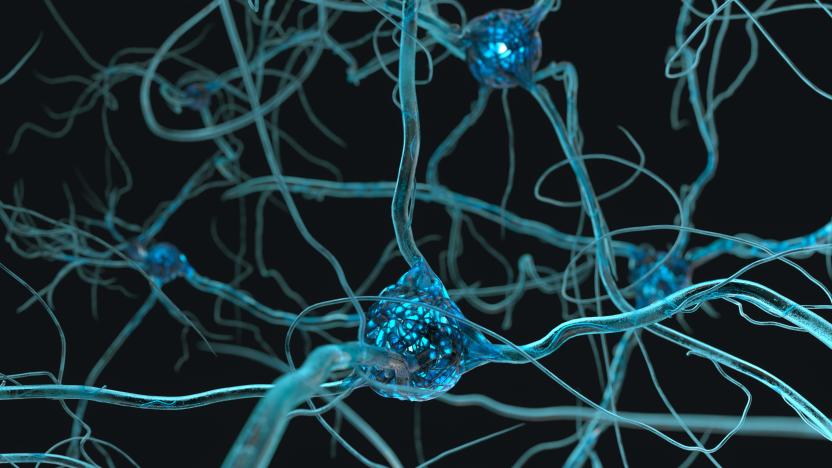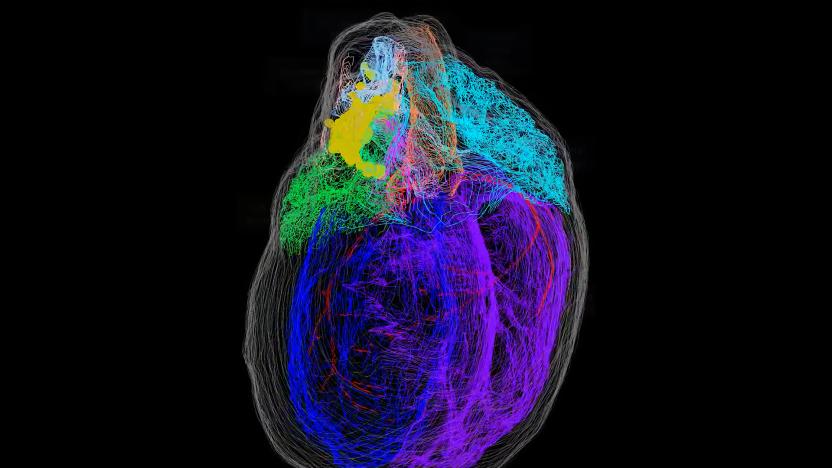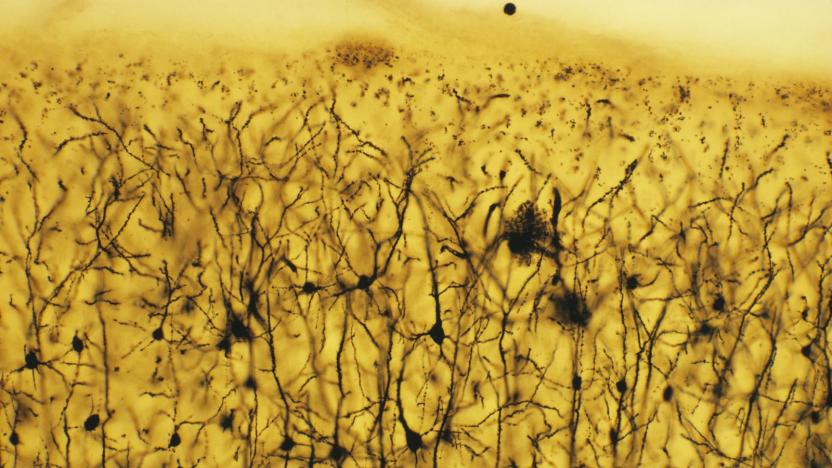neurons
Latest
![(From L) Marc, a French patient suffering from parkinson's disease, fitted with a new neuroprosthesis, walks in front of Swiss Professor of neuroscience at the Swiss Federal Institute of Technology in Lausanne (EPFL) Lausanne University Hospital (CHUV) and Lausanne University (UNIL) and co-director of NeuroRestore, Gregoire Courtine, project manager Tomislav Milekovic, project manager and head of Parkinson's activities at NeuroRestore, Eduardo Martin Moraud, swiss neurosurgeon professor and co-director of NeuroRestore Jocelyne Bloch, in Lausanne, on November 3, 2023. Neuroscientists from Inserm, CNRS and the University of Bordeaux in France, together with Swiss researchers and neurosurgeons (EPFL/CHUV/UNIL), have designed and tested a 'neuroprosthesis' designed to correct the walking problems associated with Parkinson's disease. (Photo by GABRIEL MONNET / AFP) / "The erroneous mention appearing in the metadata of this photo by GABRIEL MONNET has been modified in AFP systems in the following manner: [Marc] instead of [Marc Gautier]. Please immediately remove the erroneous mention[s] from all your online services and delete it (them) from your servers. If you have been authorized by AFP to distribute it (them) to third parties, please ensure that the same actions are carried out by them. Failure to promptly comply with these instructions will entail liability on your part for any continued or post notification usage. Therefore we thank you very much for all your attention and prompt action. We are sorry for the inconvenience this notification may cause and remain at your disposal for any further information you may require." (Photo by GABRIEL MONNET/AFP via Getty Images)](https://s.yimg.com/uu/api/res/1.2/tdtK0Xv4W3J2gC_fTGeOZg--~B/Zmk9ZmlsbDtoPTQ2ODtweW9mZj0wO3c9ODMyO2FwcGlkPXl0YWNoeW9u/https://s.yimg.com/os/creatr-uploaded-images/2023-11/5a0bb180-7cd8-11ee-af7e-830ba71eb29d.cf.jpg)
Spinal implant allows Parkinson’s patient to walk for miles
A Parkinson’s patient can now walk 6km (3.7 miles) thanks to an implant targeting the spinal cord. The man, 62-year-old “Marc” from Bordeaux, France, developed severe mobility impairments from the degenerative disease.

Scientists create the most complex map yet of an insect brain's 'wiring'
Scientists have created the most advanced "circuit map" of the brain so far, with a price wiring diagram of a fruit fly larva.

Creating the first 3D map of the heart's 'brain'
The heart has its own mini-brain called the intracardiac nervous system (ICN), which fine tunes external autonomic signals and keeps the heart pumping smoothly. The ICN consists of a layer of neurons distributed around the heart that control various cardiac functions.

An algorithm could make CPUs a cheap way to train AI
AI is the backbone of technologies such as Alexa and Siri -- digital assistants that rely on deep machine learning to do their thing. But for the makers of these products -- and others that rely on AI -- getting them "trained" is an expensive and often time-consuming process. Now, scientists from Rice University have found a way to train deep neural nets more quickly, and more affordably, through CPUs.

Playing ‘Pokémon’ as a kid may have rewired your brain
If you played Pokémon video games extensively as a kid, there's a good chance that a specific region of your brain gets fired up when you see the characters now. In a recent study, researchers from Stanford University showed test subjects hundreds of Pokémon characters. As you might expect, the brains of longtime Pokémon fans responded more than those unfamiliar with the game. But what's more surprising is that, in all of the fans, a specific brain fold responded, an area just behind the ears, called the occipitotemporal sulcus.

Brain region that recognizes faces keeps growing in adulthood
Neurologists thought that your brain was basically set once you hit early childhood, but researchers from Stanford have discovered one part that keeps growing. Using new MRI imaging techniques, they found that the "fusiform gyrus," which is mostly responsible for recognizing human faces, keeps expanding well after other regions have stopped. The research could lead to more sophisticated cellular analysis of the brain and help patients with a disorder called "facial blindness."

ICYMI: Relax while a robot takes care of your yard work
try{document.getElementById("aol-cms-player-1").style.display="none";}catch(e){}Today on In Case You Missed It: Kobi is a yard work robot that is purportedly able to clean leaves, mow the lawn and shovel snow, though the promo video shows it very briefly moving snow only, so stand by for reviews on that rush purchase. Meanwhile UCSF researchers found that infant brains actually move neurons around up to three months after birth, which is not something we'd known before. The self-driving car experiment out of the University of Oxford wrapped up with a sweet little send-off video. If you're interested in the LED suit from Red Bull, that video is here. As always, please share any interesting tech or science videos you find by using the #ICYMI hashtag on Twitter for @mskerryd.

Watch a worm's brain light up as it plots its next move
Scientists have created the first ever video of neurons firing in a freely moving animal, a technique that could lead to greater understanding about how our own brains work. The Princeton-led team first programmed a nematode worm's neurons to create a fluorescent protein that lit up in response to calcium. Since calcium is generally present when a neuron fires, that means they could literally visualize the 1 millimeter-long worm "thinking" as it wriggles around. The resulting video (below) shows 77 of the nematode's 302 neurons working in the top panel, while the bottom panel simultaneously shows its activities and brain position.

Obama's 2013 'BRAIN' initiative results in remote-controlled mice
The first results to stem from President Barack Obama's 2013 "Brain Research through Advancing Innovative Neurotechnologies" initiative are in, Reuters reports. As noted in the journal Neuron, scientists were able to manipulate the brain circuitry of lab mice, making them move, stay still, eat or leave their bowls of food behind. This was accomplished through the use of DREADDs, "designer receptors exclusively activated by designer drugs." The DREADDs system uses genetically engineered brain neurons to create custom receptors that lock into manmade molecules, activating whichever neuron scientists target. The DREADD method is a noninvasive form of behavior control, first introduced about a decade ago as a way to turn neurons on or off -- the newest DREADDs are the first to be able to do both.

The Big Picture: a closer look at live rodent nerve cells
What you're looking at up above isn't a crazy anaglyph 3D image. Well, at least not intentionally. It's actually the result of a decade-old tagging method that researchers at the European Molecular Biology Laboratory in Italy are now using in live mice. The method, called SNAP-tagging, uses proteins that latch onto specific chemical structures and don't let go. To explore rodent nerves, researchers genetically engineered the mice to produce SNAP proteins and then injected the vermin with fluorescent probes that the proteins would attach to. This allows them to be followed through the body with a microscope. For example, in the picture above, the thick blue lines are hairs and the red bundles are nerves.

Scientists create fully-functional brain neurons from mouse skin cells
It's a good excuse to shoehorn Pinky and the Brain on to the site, but scientists have managed to graft neurons reprogrammed from skin cells into the brains of mice. It isn't the first time that's been done, but it is the first time the researchers have had any luck with the neurons surviving into long-term stability. Better still, six months after implantation, the neurons had become fully-functional inside the brain. Cell replacement therapy would be able to treat neurodegenerative diseases like Parkinson's, replacing non-working neurons with new cells reprogrammed from elsewhere. It's still a ways off, however, according to stem cell research head Prof. Schwamborn: "I am sure successful cell replacement therapies will exist in future. Our research results have taken us a step further in this direction."

Intel designs neuromorphic chip concept, our android clones are one step closer
Most neurochip projects have been designed around melding the brain and technology in the most literal sense. Intel's Circuit Research Laboratory, however, is betting that we might get along just fine with neuromorphic (brain-like) computers. By using valves that only have to respond to the spin of an electron, as well as memristors that work as very efficient permanent storage, the researchers believe they have a design that operates on the same spikes of energy that our noggins use rather than a non-stop stream. Along with simply using power levels closer to those of our brains, the technique allows for the very subtle, massively parallel computations that our minds manage every day but which are still difficult to reproduce with traditional PCs. There's still a long path to take before we're reproducing Prometheus' David (if we want to), but we've at least started walking in the right direction.

DNA-based artificial neural network is a primitive brain in a test tube (video)
Many simpler forms of life on this planet, including some of our earliest ancestors, don't have proper brains. Instead they have networks of neurons that fire in response to stimuli, triggering reactions. Scientists from Caltech have actually figured out how to create such a primitive pre-brain using strands of DNA. Researchers, led by Lulu Qian, strung together DNA molecules to create bio-mechanical circuits. By sequencing the four bases of our genetic code in a particular way, they were able to program it to respond differently to various inputs. To prove their success the team quizzed the organic circuit, essentially playing 20 questions, feeding it clues to the identity of a particular scientist using more DNA strands. The artificial neural network nailed answer every time. Check out the PR and pair of videos that dig a little deeper into the experiment after the break.

Researchers build synthetic synapse circuit, prosthetic brains still decades away
Building a franken-brain has long been a holy grail of sorts for scientists, but now a team of engineering researchers have made what they claim to be a significant breakthrough towards that goal. Alice Parker and Chongwu Zhou of USC used carbon nanotubes to create synthetic synapse circuits that mimic neurons, the basic building blocks of the brain. This could be invaluable to AI research, though the team still hasn't tackled the problem of scope -- our brains are home to 100 billion neurons, each of which has 10,000 synapses. Moreover, these nanotubes are critically lacking in plasticity -- they can't form new connections, produce new neurons, or adapt with age. All told, the scientists say, we're decades away from having fake brains -- or even sections of it -- but if the technology advances as they hope it will, people might one day be able to recover from devastating brain injuries and drive cars smart enough to avert deadly accidents.

New research suggests our brains delete information at an 'extraordinarily high' rate
The mysteries of the brain may be virtually endless, but a team of researchers from two institutes in Göttingen, Germany now claim to have an answer for at least one question that has remained a puzzle: just how fast does the brain forget information? According to the new model of brain activity that the researchers have devised, the answer to that is one bit per active neuron per second. As Fred Wolf of the Max Planck Institute for Dynamics and Self-Organization further explains, that "extraordinarily high deletion rate came as a huge surprise," and it effectively means that information is lost in the brain as quickly as it can be delivered -- something the researchers say has "fundamental consequences for our understanding of the neural code of the cerebral cortex."

Harvard University controls worm with laser, we wait for choreographed dance moves (video)
Researchers at Harvard University's Center For Brain Science have successful manipulated nematode C. elegans worms by genetically modifying a select few of their 302 neurons. Not to be confused with magnetically controlled invertebrate, these creepy-crawlies are controlled by the CoLBeRT system (a nod to the comedian but no other relation), controlling locomotion and behavior in real time. The scientists can manipulate movement of the worms, induce paralysis, and even cause them to lay eggs all by shining a laser that turns on and off the modified cells at will. The laser hits the worm and causes it to react as if it were being touched. According to the researchers, the reaction is similar to when light is shined in a human eye -- the protein found in the worm and eyes are sensitive to different variations of rays and will respond based on the color shined. Peep past the break for some squiggly mind- er, light-controlled action.

Optogenetics hold the key to future brain disease cures, still creep us out
Those mad neuroscientists, they'll never learn, but maybe in the end we'll all be better off for it. Wired has put together an extremely intriguing write-up of the short history of optogenetics -- featuring a German pond scum researcher, a Nobel Prize winner, and rat brains controlled by beams of light. Optogenetics is a relatively new technique for communicating with the brain, which involves the implantation of particular light-sensitive genes into animals with the purpose of repairing neurological ailments through light therapy (no, not that kind). By hooking up fiber-optic cables to the affected area of the brain, researchers have been able to completely restore movement in mice with Parkinson's disease and their current efforts revolve around developing a less invasive method that doesn't go deeper than the outer surface of the brain. Most revolutionary of all, perhaps, is the eventual possibility for two-way traffic (i.e. a machine being able to both send and receive information from the brain), which brings all those cyborg dreams of ours closer to becoming a reality than ever before. Hit up the read link for the full dish.











